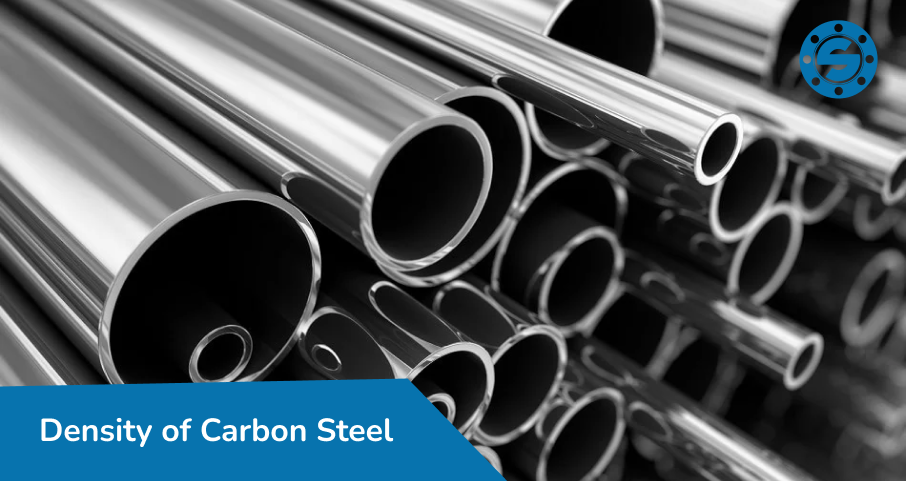Density of Carbon Steel

Carbon steel is a strong material made primarily of iron and carbon, with small amounts of other elements. Its durability and strength make it widely used across various industries. The carbon content in carbon steel can vary, with higher levels providing greater hardness and strength. However, higher carbon content can also make the steel more brittle and challenging to work with.
This versatile material is commonly used in construction, automotive manufacturing, and machinery production. It’s also popular for making knives and tools due to its sharpness and durability. Carbon steel is favored in manufacturing because it is cost-effective and easy to work with.
However, carbon steel is prone to rust and corrosion if not properly treated or coated. Despite this, it remains an adaptable material that can be easily welded and shaped to meet various needs.
What is the Density of Carbon Steel?
Why is the density of carbon steel important?
The density of carbon steel is crucial in engineering and manufacturing because it directly impacts the weight of the material and its strength-to-weight ratio. This, in turn, affects the overall design, structural integrity, and performance of the final product. Understanding the density helps engineers calculate load-bearing capacity, material requirements, and optimize the design for various applications, ensuring that the product is both strong and efficient.
What is Factors Affecting Carbon Steel Density
- Carbon Content: The amount of carbon in the steel affects its density. Higher carbon content generally leads to an increase in density due to the addition of carbon atoms into the steel matrix.
- Heat Treatment: The heat treatment process can influence the density by altering the microstructure of the steel. Different treatments can change the arrangement and size of grains within the steel, impacting its overall density.
- Temperature and Pressure: The conditions under which steel is processed or used can affect its density. High temperatures may cause expansion, reducing density, while high pressure can compress the material, increasing its density.
- Grain Size: The grain size within the steel’s microstructure impacts its density. Finer grains can lead to a more compact structure, potentially increasing density, whereas larger grains might result in lower density.
- Surface Treatment: Treatments like coating or galvanizing the steel surface can alter the density, especially when these treatments add mass or change the material’s surface properties.
How to measure carbon steel density?
For practical applications like a Carbon Steel density, density can be calculated using a simple formula.
Formula for Density in Kg per Meter:
Density (Kg/m)=Outer Diameter (OD) in mm×Outer Diameter (OD) in mm×0.00623
Example:
For an 80mm round bar:
(80mm×80mm)×0.00623=39.872Kg per meter
This calculation gives the weight per meter of the carbon steel round bar, which is directly related to its density.
How Does Density Affect Carbon Steel Properties? 5 reasons which can affect carbon steel properties
1. Strength:
Impact: Higher density in carbon steel generally correlates with a higher strength-to-weight ratio. This means that denser carbon steel can bear more load or force relative to its weight, making it stronger and more resilient against deformation under stress.
2. Malleability and Ductility:
Impact: Density also influences the material’s ability to deform under compressive stress (malleability) or tensile stress (ductility). High-density carbon steel is often less malleable and ductile because the tightly packed structure makes it harder for the material to deform without breaking.
3. Electrical Conductivity:
Impact: Carbon steel with higher density tends to have lower electrical conductivity. This is because denser materials have more atoms per unit volume, leading to greater resistance to the flow of electric current.
4. Heat Capacity:
Impact: Denser carbon steel usually has a higher heat capacity, meaning it can absorb more heat energy before its temperature increases. This is beneficial in applications where the material needs to withstand high temperatures without rapidly changing temperature.
5. Thermal Expansion:
Impact: Materials with higher density typically exhibit higher rates of thermal expansion. This means that as the material heats up, it expands more due to the greater number of atoms that respond to temperature increases by moving further apart.
In summary, the density of carbon steel is a critical factor that affects its strength, deformability, electrical properties, heat absorption, and reaction to temperature changes. Understanding these relationships helps in selecting the appropriate grade of carbon steel for specific industrial applications.
Density High Carbon Steel Chart
The density of low carbon steel can vary slightly depending on the specific grade and composition, but it typically falls within the range of 7.75 g/cm³ to 8.05 g/cm³ (0.282 lb/in³ to 0.291 lb/in³).
Here is a table showing the densities of some common low carbon steel grades:
| Grade | Density (g/cm³) | Density (lb/in³) |
| AISI 1005 | 7.85 | 0.282 |
| AISI 1006 | 7.85 | 0.282 |
| AISI 1008 | 7.85 | 0.282 |
| AISI 1010 | 7.85 | 0.282 |
| AISI 1011 | 7.85 | 0.282 |
| AISI 1012 | 7.85 | 0.282 |
| AISI 1013 | 7.85 | 0.282 |
| AISI 1015 | 7.85 | 0.282 |
| AISI 1016 | 7.85 | 0.282 |
| AISI 1017 | 7.85 | 0.282 |
| AISI 1018 | 7.85 | 0.282 |
| AISI 1019 | 7.85 | 0.282 |
| AISI 1020 | 7.85 | 0.282 |
| AISI 1021 | 7.85 | 0.282 |
| AISI 1022 | 7.85 | 0.282 |
| AISI 1023 | 7.85 | 0.282 |
| AISI 1025 | 7.85 | 0.282 |
| AISI 1026 | 7.85 | 0.282 |
| AISI 1110 | 7.83 | 0.281 |
| AISI 1117 | 7.83 | 0.281 |
| AISI 1118 | 7.83 | 0.281 |
Conclusion
In summary, carbon steel’s density plays a crucial role in shaping its properties, such as strength-to-weight ratio, malleability, ductility, electrical conductivity, heat capacity, and thermal expansion. Understanding these aspects helps engineers and designers choose the right type of carbon steel for various applications, from automotive parts to construction materials.
This knowledge allows for well-informed decisions, balancing both performance needs and cost considerations. By considering the specific requirements of each project, engineers can select the most suitable grade of carbon steel, ensuring optimal performance and efficiency for their applications.


